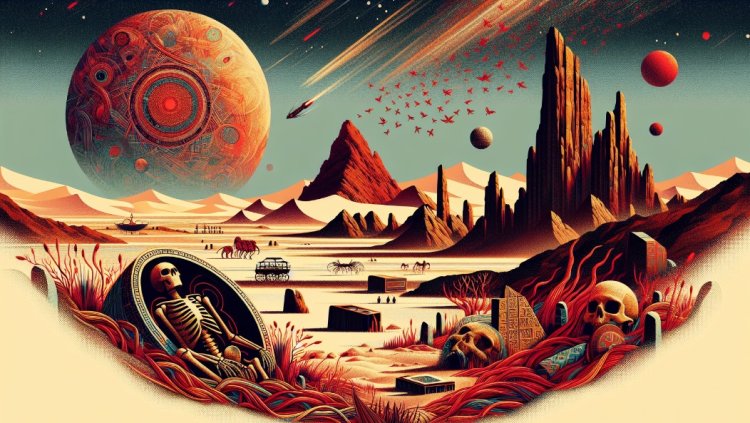Mysteries of the Ancient World: Giants, Sacred Stones, and Monoliths
Unravel the enigmas of ancient giants, sacred stones, and towering monoliths! Journey through history's most captivating mysteries, from Easter Island's Moai statues to Stonehenge's enigmatic circle.

The Giants of Lovelock Cave
In 1911, miners found something surprising in Lovelock Cave in Nevada. While searching for bat droppings, they discovered more than 40 human skeletons, including some that were unusually large. These large human skulls and skeletons were about seven to eight feet tall, which was a very large size for humans in ancient times.
What made these skeletons even more interesting was that they had red hair. Unlike the Native Americans from the area, these skeletons seemed to belong to a different kind of people. The large skeletons were very important and made people think about the Bible.
Many stories in the Bible mention a group of very large people who once lived on Earth. Some people found really large skeletons, which seemed to confirm these stories. The discovery of red hair in the skeletons also strengthened the connection to the stories from the Bible.
During the Lovelock Cave excavation, more than 100,000 items were found, including many very large ones. The artifacts had very large sandals that were 15 inches long. These sandals would fit someone about six feet tall. There was also very large clothing. These items are further evidence that giants lived at this site.
There were stories of giants in the Wild West, not just in Lovelock Cave. Throughout history, there have been reports of large bones and skeletons found in various areas of the western Nevada desert. These reports and the findings in Lovelock Cave indicate that a group of very large people may have lived in the western United States in the past.
In Native American stories, the Paiute tribe battled a group of tall, red-haired giants called Si-Te-Cah. The giants and the Paiute people fought for three years until the giants retreated into Lovelock Cave. The entrance to the cave was sealed, and the giants were defeated.
The discovery of signs of a fierce fire near the entrance to Lovelock Cave fits with Paiute's narrative that the giants were trapped in the cave and burned it. Sarah Winnemucca, who was related to Chief Winnemucca, rescued some red hair from the giants and sewed it into a mourning dress. This helped to substantiate the story of the Paiute.
Some people may not believe the stories about giants, but the evidence from Lovelock Cave, the objects found there, and the stories passed down clearly support the existence of giants in the area. Whether it was true in history or just a story told by a tribe, stories about giants continue to interest and fascinate people today.
The Black Stone of Mecca
The Black Stone of Mecca is of great importance to the Muslim faith. The Kaaba is a large stone cube weighing 43 tonnes. It is located in the Great Mosque in Mecca and is known as the House of God. Muslims all over the world look at the black stone five times a day and pray to it. This stone is considered the holiest and most sacred place in Islam.
In Islamic belief, it is said that the black stone came from heaven by Allah's command when Adam and Eve were still alive. It is believed to show where the first temple, which later became Mecca, was located. It is said that the stone was lost in the flood, but the prophet Abraham found it again. Abraham and his son Ishmael set up the first place of worship in Mecca. This made Mecca very important for Muslims.
Every year, many Muslims make a pilgrimage, the Hajj, to the Kaaba. During the pilgrimage, people perform special rituals called tawaf. One of these rituals is circumambulating the Kaaba seven times. The black stone is important during the hajj ceremony. People try to touch or kiss it, following the example of the Prophet Mohammed. He placed the stone where it is now in 605 AD.
The black stone is mighty and attractive. The Kaaba is very important to billions of Muslims. It has a strong influence on their feelings and thoughts. Some experts speculate that the black stone could have an extraterrestrial origin and suggest that it could be a meteorite. While this theory remains unproven, the idea that the stone has a connection to the heavens only makes it more mystical.
Unfortunately, no one has officially verified or examined the black stone, which makes it even more mysterious. The fact that it is considered sacred and the cultural sensitivities surrounding it make it difficult to study scientifically. Therefore, we still do not know the true properties and qualities of the black stone.
Regardless of its origin, the black stone still baffles and motivates many Muslims who use it for prayer. The black stone is very important in Islamic history and plays a major role in the Hajj pilgrimage. This makes it a symbol of faith, devotion, and unity for Muslims all over the world.
The Tombstone Pterodactyl
In the old town of Tombstone, Arizona, famous for its gunfights and tales of the Wild West, there is another interesting story that captures the attention of locals and tourists alike. It's the story of the Tombstone Pterodactyl, a really big flying creature that flew around in the late 1800s.
The famous gunfight at the OK Corral often gets more attention than the story of the Tombstone Pterodactyl. But for people who like historical mysteries, it's a story worth delving into.
In 1890, there were reports of two ranchers claiming to have seen a monster in the sky above Tombstone that looked like it came from a time long past. They said the creature was about 100 feet long and had a head that was 8 feet long. The head had very sharp teeth. Although they were scared, the ranchers found and killed the creature. They even tried to take a picture of it.
Although the supposed photo was not discovered, several pictures on the internet supposedly show the Tombstone Pterodactyl. However, some experts doubt that they are genuine and consider them to be fabricated lies.
The story of the Tombstone Pterodactyl continues to fascinate many people, even if some doubt the images. We wonder if there were large flying creatures in the Old West and if they were connected to Native American stories.
In Native American stories, the thunderbird is a powerful creature depicted as a giant bird that can make thunder and shoot lightning from its eyes. The thunderbird is often seen in drawings and carvings in the western United States.
Is there a connection between the thunderbird and the winged creature spotted in Tombstone? Some people believe that the stories about the thunderbird may stem from real-life experiences with large flying creatures, such as the Tombstone Pterodactyl.
We can't be sure if the Tombstone Pterodactyl was a real creature or just a story, but the legend adds to the interesting stories and mysteries of Tombstone. It shows us that there is still much we don't know about the history of the Old West and the creatures that may have lived there.
The Giants of Monte Prama
In 1974, a farmer in Sardinia found something amazing when he was plowing his fields in Monte Prama. He found the head of a very old, large statue. There are many other large statues in the area. The Nuragic people were an ancient civilization that lived in Sardinia about 4,000 years ago. They made these statues, which they called the Giants of Monte Prama.
What makes these statues even more interesting is their size. They are very tall, about two meters, and weigh a lot, about a tonne. They are special because they have a lot of detail and are very advanced for their time. But could these statues be more than just art? Some researchers believe that they are evidence of a real group of very large people who once lived on the island.
There are many stories about giants in Sardinian folklore. These stories often mention places where these large creatures were buried. It is interesting to note that there are mysterious tombs on the island, known as the tombs of the giants. The giant men could have been buried in these graves. The tombs are built from large blocks of stone and have a small opening at the bottom for burial.
Reports of large skeletons discovered in Sardinia provide further evidence for the theory that giants once lived on the island. In 1901, four skeletons were found that was three meters tall. More recently, three skeletons were reported to have been found in southwest Sardinia. But much of the evidence has disappeared, leading people to suspect that there may be a secret or that someone is hiding the bones.
There are different ideas about the giants of Monte Prama that go beyond Sardinia. The ancient Greek historian Diodorus wrote about a group of people from Athens whom he called the "50 sons of Hercules." They had children with ordinary women, and their descendants were giants who erected giant statues in Sardinia. This story shows a connection between the ancient Greeks and the Nuragic civilization.
The giants of Monte Prama are still a mystery, but their large statues and stories about giants are very interesting. Whether they were real giants or just works of art, they show us the ancient times and history of Sardinia.
The Global Monolith Mystery
The discovery of the monolith in Utah astounded the world. In November 2020, scientists found a large metal structure 12 feet high in the remote sandstone canyons of the Utah desert. This strange, out-of-this-world structure captured the interest of people around the world. It lingered in the desert for about four to five years without being touched or noticed, according to satellite images.
But the mystery surrounding the monolith didn't end there. Shortly after its discovery, more monoliths appeared in various places around the world. Monoliths appeared in many places, such as India, Pittsburgh, San Francisco, and Europe. More than 200 of them popped up and caught the attention of people everywhere. It seemed like there was a big worldwide event.
Some thought these monoliths were just imitations or passing trends, but historians saw their significance. They compared them to something that happened a long time ago, about 6,000 years ago, called menhirs. At that time, people in Europe erected tall, upright stones called menhirs. These stones looked similar to the monolith in Utah.
There are more than 35,000 standing menhirs in Europe, which are part of a widespread tradition. These tall structures were erected in various countries, such as Great Britain, France, Germany, Portugal, and Spain. Why were so many monoliths built during this period?
Historians say that travel and trade helped spread the practice of building monoliths. When people saw these impressive structures while traveling, they felt motivated to build similar ones in their cities. People wanted to remember, understand, and build monuments, so they copied and built their monoliths.
The worldwide trend of imitating and copying things is similar to what happened in the past. The Utah monolith fascinated people, and they felt the need to make their own copies. The monoliths became symbols that made people curious and confused about where they came from and why they existed.
The worldwide monolith phenomenon reminds us that humans like to erect impressive and long-lasting monuments, even if we don't know why. Monoliths have always fascinated and inspired people, both in the past and today.
The Enigmatic Menhirs of Europe
Europe has many interesting ancient monolithic structures called menhirs. These tall stones, which look like the Utah monolith, were placed all over Europe about 6,000 years ago. Menhirs were common in ancient Europe. This makes us think about the past and makes it even more mysterious.
The purpose of menhirs is a very interesting mystery. Historians have studied these structures in depth, but we still don't know exactly what they mean or what they were used for. Some theories suggest that menhirs were used for ceremonies or religious purposes, while others believe that they were used as markers or stones to mark boundaries.
What makes the menhirs even more interesting is the possibility that they were copied in various places. The widespread practice of erecting menhirs suggests that people were motivated to erect similar structures in their own towns. Travel and trade probably contributed to the spread of this practice, as people saw and liked the large standing stones when they were traveling.
Today, there are more than 35,000 standing stones in Europe. They can be found in countries such as Great Britain, France, Germany, Portugal, and Spain. These ancient, tall stones show that humans have a strong desire to erect long-lasting and impressive monuments. Menhirs continue to fascinate and captivate us, whether they were erected for religious, cultural, or symbolic reasons.
The many menhirs in Europe make us wonder what they mean and what stories they have. Each menhir shows a part of our ancient history—a small glimpse into the lives and beliefs of the people who came before us. They remind us of our human connection to the past and our natural desire to leave a lasting legacy.
We may never fully understand the true meaning and purpose of the menhirs, but their presence and mystery remind us how mysterious our ancient world is. The tall stones in Europe still arouse people's curiosity and make them want to explore more. They make us want to learn more about our shared history.
Conclusion: Uncovering the Mysteries
Ancient times had many secrets that still interest and fascinate us today. The giants in Lovelock Cave and the black stone of Mecca are mysterious things that amaze us.
Ancient mysteries are often about the possible connections between different phenomena. Giant skeletons found in Lovelock Cave and stories of red-haired giants in Native American folklore suggest that giants may have existed in the Old West. Some experts believe that the black stone of Mecca may have come from outer space, making it even more mysterious and attractive.
Folk stories, ancient tales, and historical documents are important in solving these mysteries. The Paiute people's story of fighting the Si-Te-Cah giants fits with the evidence discovered in Lovelock Cave. The stories of the thunderbird in Native American mythology make us wonder if they are related to the winged creature in Tombstone.
However, investigating and securing evidence has its own difficulties. The large bones in Sardinia are missing, and the difficult access to the Black Stone of Mecca makes it hard for scientists to study them. These obstacles make it difficult to fully understand the true nature and characteristics of these ancient objects.
Despite these difficulties, people still find things they don't know fascinating. We are drawn to uncovering ancient truths and learning more about our past, which makes us want to explore these mysteries further. People are always trying to find out about the past. They do this by finding old things, studying stories, or doing scientific research.
To summarise, the mysteries of ancient times are still of great interest. People are always interested in giants, sacred stones, and monoliths because they want to know more about mysterious things. As we find more evidence, connect various events, and explore stories and myths, we learn important things about our ancient history. The process of exploration is what keeps us interested in the mysteries of the ancient world, even when the solutions may not be obvious.



 admin
admin 










